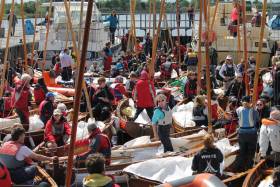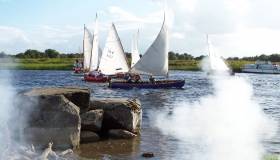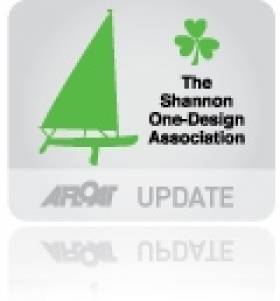Displaying items by tag: Shannon One Design
Shannon One Designs To Launch Centenary Year With Sold-Out Mad March Dinner in National YC
There are highly individualistic One Design Classes. And then there are the 1922-founded Shannon One Designs. They’re in a league of their own. And they’ll be launching their Hundred Year Programme for 2022 with a Centenary Dinner in the National Yacht Club in Dun Laoghaire Harbour on Saturday 5th March, with the class’s spirit being revealed by the fact that all tickets were sold out within 12 hours of the event being opened for business by Class Chairman Philip Mayne and Honorary Secretary Naomi Algeo.
Although the class races almost exclusively on the great lakes of the Shannon, it makes occasional excursions to other places like Lough Corrib in Galway and Lough Owel in Westmeath, while they made an impressive Dun Laoghaire debut in the sailing events of the 1924 Tailteann Games on Dublin Bay, when they returned home with the Gold Medal.
 The Shannon ODs have been providing close competition ever since their first race. It is believed to have been on Thursday 24th August 1922 on Lough Ree, though the first contest properly recorded was on Lough Bofin with the North Shannon YC on Tuesday 29th August 1922, won by Dr V Delany with Kiwi. Photo courtesy SODA
The Shannon ODs have been providing close competition ever since their first race. It is believed to have been on Thursday 24th August 1922 on Lough Ree, though the first contest properly recorded was on Lough Bofin with the North Shannon YC on Tuesday 29th August 1922, won by Dr V Delany with Kiwi. Photo courtesy SODA
Such is this una-rigged 18ft clinker-built dinghy’s unique appeal that owners are to be found in more than half of the counties of Ireland. And as many of them winter - so to speak - in Dublin, a Springtime seasonal opening get-together with gala overtones at the hospitable National Yacht club will fit the bill to perfection.
The class has long links with the NYC, as the Earl of Granard, NYC Commodore from 1931 to 1941, was also involved with County Longford’s North Shannon YC, one of the clubs which made an active input into the foundation of the class in 1921-22.
More recently, the NYC Commodore was Con Murphy from 2005 to 2008, and his wife – former Olympic sailor Cathy Mac Aleavey - is not only a devoted Shannon OD sailor, but she built her boat personally, working with the late Jimmy Furey, the legendary classic boat-builder of Leecarrow in County Roscommon.
 Olympic sailor Cathy Mac Aleavey, wife of former NYC Commodore Con Murphy, making knots with the Shannon OD she built with Jimmy Furey. Photo courtesy SODA
Olympic sailor Cathy Mac Aleavey, wife of former NYC Commodore Con Murphy, making knots with the Shannon OD she built with Jimmy Furey. Photo courtesy SODA
Olympic enthusiasm is one of the Shannon OD’s character traits, starting with Dr Alf Delany who sailed for Ireland in the 1948 and 1952 Olympics while at the same time being a leading helm in both the Dublin Bay Water Wags and the Shannon One Designs.
Afloat.ie’s W M Nixon, who will be one of the speakers at the Dinner in the NYC on March 5th, was introduced to the Shannon ODs by sailing with Alf Delany at the Golden Jubilee Regatta at Lough Derg YC in Dromineer in August 1972.
“It was remarkable sailing with Alf” he recalls, “it was as though he and the boat became one, and despite his tyro crewmate, we were in the frame in both races sailed. As for the Shannon One Designs as a class and as a colourful group of people, I was immediately mesmerized, and have remained so ever since.”
 Bendy boats do best…..Among the more fascinating aspects of the Shannon One Design is their hull flexibility in a good wind – “In a strong breeze, they’ll turn round and look at you”. Photo SODA
Bendy boats do best…..Among the more fascinating aspects of the Shannon One Design is their hull flexibility in a good wind – “In a strong breeze, they’ll turn round and look at you”. Photo SODA
Shannon One Designs Seek Calendar Girls
When a Centenary arrives, most of those closely involved tend to focus on the history they’re celebrating, whether it’s a club or a boat class or whatever. Sometimes they become immersed in potentially challenging and even contentious projects like re-enactments, which the more snooty purists would tell us is “History for Those of Limited Attention Span and Small Imagination”.
But the 18ft Shannon One Designs didn’t get so successfully to their Centenary in 2022 by dwelling excessively on the past, as was revealed in the write up on their accolade as “Sailing Club of the Year 2022”, which they share with Lough Ree Yacht Club. On the contrary, they honoured the establishment of the new Irish Free State in their own foundation year of 1922 with enthusiastic involvement in the sailing events in Dublin Bay of the Tailteann Games in 1924 to celebrate the new nation, and were suitably rewarded by returning home with the Gold Medal to their great lakes along Ireland’s largest river.
Thus the Shannon ODs have not only adapted to change, from time to time they’ve actively shaped it, and they do this by living very actively in the present every bit as much they fondly recall their colourful past.
It’s entirely in keeping with this that one of the projects they have in hand for 2022 is what will eventually be a profusely-illustrated calendar for 2023, in which each monthly photograph will be from the matching month of 2022, showing this unique class’s way of life through the four seasons.
It is already under way with photo fans recording Shannon ODs in January in their widely varying winter quarters, which would make a book in itself. And the scope will widen as the year progresses, with the winners being initially publicised through this year on a monthly basis - a procedure which will emphasise the theme of living in the present while honouring the past.
Lough Ree Yacht Club & Shannon ODs Share MG Motors “Sailing Club of the Year” Award for 2022
Lough Ree Yacht Club and the Shannon One Design Association are sharing this year’s MG Motors Sailing Club of the Year Award. It’s the well-deserved honouring of a dynamic combination that provides a core contribution to the Athlone area’s reputation as a hotbed of Irish sailing advancement and was recognised back in 2008 when they previously were joint winners.
At that time, Shannon OD numbers were expanding at an unprecedented rate, while Lough Ree YC was settling into an enlarged clubhouse which facilitated the club’s growth as a national focal point for sailing in Ireland, both as a venue afloat and a meeting place ashore.
In this new award some fourteen years later, there are two vital extra elements to add to the healthy combination which was so outstanding in 2008 and continues today. In 2020, Lough Ree YC should have been celebrating its Quarter Millennium in exuberant style, but the fact that - with its foundation in 1770 - the Club is possibly the second-oldest in the world had to be marked in a COVID-muted way, and thus 2022 hopes to see LRYC celebrate Quarter Millennium + 2, if anything with added zest.
 Lough Ree Yacht Club at Ballyglass. The club has steadily increased its land-holding, and with activity and membership increasing on a strongly family basis, it is contemplating further extension of the premises and facilities afloat and ashore
Lough Ree Yacht Club at Ballyglass. The club has steadily increased its land-holding, and with activity and membership increasing on a strongly family basis, it is contemplating further extension of the premises and facilities afloat and ashore
But for the Shannon One Designs, 2022 is it - the Centenary Year. In making the award, we will be celebrating one of the most remarkable classes in the world, a class which - thanks to its classic clinker-built construction - is now recognised as being of special Heritage Significance, with official UNESCO recognition of this ancient-yet-updated method of boat-building.
 Walter Levinge of Lough Ree YC built many of the Shannon One Designs in the early days of the class from 1922 onwards, and was active in boat-building and sailing until the 1960s. His clinker construction of these classic boats was of a quality well deserving of the recently-awarded UNESCO Heritage Status.
Walter Levinge of Lough Ree YC built many of the Shannon One Designs in the early days of the class from 1922 onwards, and was active in boat-building and sailing until the 1960s. His clinker construction of these classic boats was of a quality well deserving of the recently-awarded UNESCO Heritage Status.
In fact, so much of long-term sailing heritage is to be found in and around the southeast corner of Lough Ree that perhaps the entire area should be declared a UNESCO Heritage Site, for in addition to the Lough Ree YC complex, it includes the location where the legendary Walter Levinge built many of the early Shannon One Designs in addition to other classic clinker-built designs, and it also includes the newly re-configured headquarters of the Inland Waterways Association of Ireland.
LOUGH REE YACHT CLUB
It’s probable that organised sailing of some sort was taking place on Lough Ree long before 1770, but the records from 1770 prove beyond doubt that something was under way by that time. And though the name Lough Ree Yacht Club was not always the title being used, it’s the one that has lasted, even if within the past hundred years the club activity had sometimes become thin enough.
That said, dedicated families like the Murtaghs of Athlone kept the flame alight, even though - in the very thin years of the 1950s - if it hadn’t been for Sid Shine of Athlone making his houseboat/barge The Fox available for use as a clubhouse when required, LRYC might have become an idea rather than something tangible.
 Jimmy Furey and Sid Shine. The late Jimmy Furey of Leecarrow on Lough Ree took over the Levinge mantle as the leading builder of Shannon ODs of the highest standard, while Sid Shine of Athlone was a dedicated sailing enthusiast who played a central role in keeping Lough Ree YC going through the thin years of the 1950s. Photo: W M Nixon
Jimmy Furey and Sid Shine. The late Jimmy Furey of Leecarrow on Lough Ree took over the Levinge mantle as the leading builder of Shannon ODs of the highest standard, while Sid Shine of Athlone was a dedicated sailing enthusiast who played a central role in keeping Lough Ree YC going through the thin years of the 1950s. Photo: W M Nixon
That is something difficult to imagine as we contemplate the contemporary thriving clubhouse/dinghy park/boatyard/marina complex at Ballyglass. As proof of the club’s thriving good health, it has managed to keep a busy if truncated COVID-compliant programme going during the regulation periods under current Commodore John McGonigle, who incidentally is Ireland’s leading classic watch-maker. And before that in 2020 itself with his predecessor Garrett Leech, there was as much activity afloat as possible, and a continuing programme of acquiring extra land which has led to LRYC having a total site of six acres. This will facilitate the re-routing of the access road and other amenities, thereby making the interaction between the clubhouse and the on-water facilities more user-friendly, while providing a launching pad for further clubhouse expansion.
 The secret life of yacht club flag officers…..John McGonigle, Lough Ree YC Commodore, is Ireland’s leading creator of customised classic wrist watches
The secret life of yacht club flag officers…..John McGonigle, Lough Ree YC Commodore, is Ireland’s leading creator of customised classic wrist watches
Virtually all of this has been done with voluntary effort as far as the actual running of the club is concerned. Yet that’s something the members take in their stride as they focus on sailing, with one of their peak interests being the Olympic 49er duo of Rob Dickson and Sean Waddilove. Although the pair are generally associated with the east coast Fingal clubs of Howth and Skerries, Rob Dickson’s total passion for sailing was basically shaped around family holidays on the Shannon with the focus on Lough Ree YC, and while his head may be in Fingal or at some major international venue, his heart is on Lough Ree.
 Lough Ree is renowned for its big skies, seen here making shapes over the LRYC SB20 Class.
Lough Ree is renowned for its big skies, seen here making shapes over the LRYC SB20 Class.
There, the LRYC fleet is eclectic, with a strong emphasis on family and junior sailing through Optimists, Mirrors and 420s in addition to the Shannon ODs, while they’re also a stronghold of Cruisers and the SB20 Class, having provided the SB20s with their exuberant “Pandemic President” John Malone, who enthusiastically led his fleet both at LRYC and nationally into as much activity as was permitted, making them one of Ireland’s busiest classes.
 LRYC is noted for its encouragement of youth classes, and while the 420s can enjoy its best summertime racing condition………
LRYC is noted for its encouragement of youth classes, and while the 420s can enjoy its best summertime racing condition……… ….there are many times when the lough reminds them that is basically an inland sea.
….there are many times when the lough reminds them that is basically an inland sea.
But like all LRYC classes, the Lough Ree SB20s’ first loyalty is to their own home waters, and the way that they and all the sailors of Lough Ree YC interact in the most positive way with their own local community is an aspect of the club which the adjudicators find particularly inspiring. This soothing vid of a lone Shannon One Design sailing on the lake at Ballyglass tells us much about why the LRYC approach works so well:
SHANNON ONE DESIGN ASSOCIATION
Any organization which was founded in Ireland a hundred years ago will have found its earliest experiences coinciding precisely with the birth throes of the Irish Free State, which between 1919 and 1922 included a War of Independence, and the Civil War fought over the Treaty which resulted from the Independence conflict.
Thus the establishment of the Shannon One Design Association between the members of the North Shannon YC on Lough Bofin in Longford, Lough Ree YC at Athlone, and Lough Derg YC at Dromineer took place in a sort of parallel universe in which many people were trying to get on with some sort of normal life, while others in relatively confined areas were prepared to fight to the death for their objectives.
 An early Shannon One Design clearly revealing the class’s noted hull flexibility
An early Shannon One Design clearly revealing the class’s noted hull flexibility
The ability to live with parallel situations was already almost normal in Ireland, for after the Sinn Fein victory in the 1918 General Election, an alternative government to that ruling from Dublin Castle was established under the new and “illegal” Dail, such that in many parts of the country, it was quietly if almost invisibly accepted as the real administration which either got things done, or prevented the supposedly official government from performing its more mundane functions.
In such circumstances, and with the River Shannon available to provide them with the means of travel should various roads and railways be blocked by felled trees or detonated bridges, the task of setting the Shannon One Design Association in being was put in motion, the key meeting being a gathering in the Prince of Wales Hotel in Athlone on January 20th 1920.
 It may have started with a tentative January meeting in Athlone in 1920, but since then the Shannon One Designs have become one of the wonders of Irish sailing, as seen here with the class making a boisterous start in racing at Dromineer on Lough Derg, with John & Sandra Lefroy’s 1873-vintage iron-built Phoenix as Committee Boat. Photo SODA
It may have started with a tentative January meeting in Athlone in 1920, but since then the Shannon One Designs have become one of the wonders of Irish sailing, as seen here with the class making a boisterous start in racing at Dromineer on Lough Derg, with John & Sandra Lefroy’s 1873-vintage iron-built Phoenix as Committee Boat. Photo SODA
We get a fascinating insight into the mood and attitude of those involved through the 1972-published Golden Jubilee History of the class by L. M. “Bunny” Goodbody. For the most part, those originally involved lived in big house on the lakes and along the river, or were top professional and business people in the Shannon port towns. Nicknames were almost the norm – Bunny Goodbody had a formidable female relative, Posie Goodbody, whose most famous of many achievements was to set off at dawn from Killaloe in her hyper-fast motor-powered hydroplane, and by sunset she was at Lough Key, having power-boated in one span of daylight through the length of the Shannon.
Then as the Shannon ODs – or Sods as everyone called them – got going after many discussions, their long-serving timekeeper was one Henry R Newland MA (TCD), whom you might expect to be called Harry or even Hal, but you’d be wrong. Everyone knew him as Tulip.
With noted longtime Shannon sailing families like the Delanys, Murtaghs, Hogans, Lefroys, Levinges, Lysters, Moerans, Devenishes, Handcocks, Wallers, Goodbodies and Boltons involved from the start, it’s not surprising to learn that some of these talented individuals expected their own self-created designs to become the standard boat for the new 18ft una-rigged class, so perhaps it was a peace-making ploy to go to the English designer Morgan Giles of Devon for the designs.
He produced something whose hull looked in profile like his recently-created clinker-built Essex One-Design, but the proposed SOD was much narrower and this – with the una rig - changed the character of the boat completely to make it truly expressive of the classic Irish lake boat with a substantial sail added.
 Shannon OD designer Frank Morgan Giles of Devon created some noted dinghy classes. However, when his original plan for a dipping-lug mainsail for the Shannon One Designs in 1921 was soon changed by the class to a much neater gunter lug, they only told him after it had been done, resulting in frosty relations for 35 years.
Shannon OD designer Frank Morgan Giles of Devon created some noted dinghy classes. However, when his original plan for a dipping-lug mainsail for the Shannon One Designs in 1921 was soon changed by the class to a much neater gunter lug, they only told him after it had been done, resulting in frosty relations for 35 years.
The sail immediately caused trouble. Giles had designed it as a lug sail, and despite the increasing presence in Ireland of the International 12 dinghy with its very effective standing lug, the Shannon sailors seem to have been provided with a dipping lug.
This was an infernal nuisance, so they quickly changed it to a gunter lug, and almost as an afterthought, they sent a letter about the change to Morgan Giles. He replied in such a frosty style that there was a stand-off in friendly relations for something like 35 years before any sort of client-designer harmony was properly restored.
This may have been something to do with the Irish situation, for while the new class merrily went ahead with Walter Levinge building seven boats to the new design for the 1922 season, the Civil War was causing sporadic violence in Ireland, and increasing hostility and incomprehension in England.
Yet those who were determined to get the new class going and continue to live in Ireland knew well the mood of their people among whom they lived, whatever their own political views. A certain mutual tolerance, understanding and respect was needed.
Thus when the new class was finally lined up for its first proper race on Wednesday, August 23rd 1922 at Lough Ree YC at Ballyglass, as the L. M. Goodbody Shannon OD History of 1972 records: “Wednesday brought the news of the death in action in West Cork of General Michael Collins, the Commander in Chief of the National Army, and in consequence all racing that day was suspended”.
Referring to the former guerilla leader as General Collins was something which had first emerged from Winston Churchill and F E Smith - of all people – during the long and tedious Treaty negotiations. But the fact that it should have appeared as a natural part of the first history of the Shannon One Designs tells us much about how the class’s members – as natural conservatives – were already anticipating di Lampedusa’s philosophy that those who wish things to stay basically the same must give a subtle lead in controlled change.
Consequently, when an invitation was extended to the expanding new class to take part in the Tailteann Games in 1924 to celebrate the new Irish Free State, it was accepted with enthusiasm, with seven SODs going to what all those involved still thought of as Kingstown. Part of the attraction was that this offered the chance to prove their mettle against the Dublin Bay Water Wags, who apparently didn’t think very highly of this new take on the traditional Shannon sailing boat.
 When the Shannon One Designs first raced on the sea with their participation in the sailing events of the Tailteann Games in 1924 at Dun Laoghaire, the big seas of Dublin Bay revealed their readiness to plane when conditions suited. It takes a bit more effort to do the same on freshwater lakes, but here we see Olympic sailor Cathy Mac Aleavey’s boat – which she built herself working with Jimmy Furey – getting up to planning speed on Lough Derg.
When the Shannon One Designs first raced on the sea with their participation in the sailing events of the Tailteann Games in 1924 at Dun Laoghaire, the big seas of Dublin Bay revealed their readiness to plane when conditions suited. It takes a bit more effort to do the same on freshwater lakes, but here we see Olympic sailor Cathy Mac Aleavey’s boat – which she built herself working with Jimmy Furey – getting up to planning speed on Lough Derg.
We tend nowadays to think that Shannon One Designs look slightly out of place on the sea, but in their 1924 expedition to Dun Laoghaire where they were based at the Royal Irish YC, they very forcefully demonstrated otherwise. On one particularly rough day when the Water Wags refused to go out of the harbour, the Shannons sallied for with gusto and revelled in the planing opportunities which the big seas of Dublin Bay provided.
Edgar Waller of Lough Derg YC sailing SOD No. 47 (they’d started their numbering at 30) won the Tailteann Sailing Gold Medal after they’d out-performed the Water Wags boat-for-boat. It was a very satisfied group that returned to their home waters, with their new boats delivered back to the Shannon in due course on flat-bed rail trucks in a joint exercise by the Dublin South Eastern Railway and the Great Southern & Western Railway.
This very convenient facility was available at Dun Laoghaire until 1961, when the entire Firefly Class, having raced their DBSC Tuesday evening contest, was transferred by launching trolleys to the waiting flatbed trucks on the waterfront railway, and on Friday evening their crews re-claimed them in West Cork in Baltimore Station nicely in time for Dinghy Week. It the last year in which they could so such a thing with the West Cork Line soon closing, though not all was lost - in time, the quayside Baltimore Railway Station became the first Glenans Base in Ireland.
 The swans in the evening – Shannon One Designs return to port
The swans in the evening – Shannon One Designs return to port
Meanwhile, the Shannon One Designs built steadily through the 1920s and ’30s, with all transport needs between regattas being provided by sundry motor-cruisers when the wind didn’t suit. The North Shannon Yacht Club on Lough Bofin more or less expired after 1929, but this enabled a more compact programme between Lough Ree and Lough Derg to be devised for August, when many of the Shannon OD sailors returned on leave from remote postings in distant places – it’s said you could find photos of Shannon One Designs displayed on walls in District Offices in dusty places up towards the Khyber Pass.
Thus the user-friendly system of a week on Lough Ree followed by a week on Lough Derg developed, with additional spice being added to the summer’s doings with a long-distance race from Athlone down-Shannon to Lough Derg, with a midway stop at Shannonbridge and sustenance from the house speciality of hot rum and chocolate at Killeen’s pub.
 They’ll always be trying something new – as August approaches, in distant parts of the world people will be dreaming of getting home to Ireland and trying a new trick or two in Shannon OD racing.
They’ll always be trying something new – as August approaches, in distant parts of the world people will be dreaming of getting home to Ireland and trying a new trick or two in Shannon OD racing.
With class numbers continuing to expand as the challenge of building boats to the required high standard passed from Walter Levinge of Athlone to Jimmy Furey of Leecarrow and then since his demise (at a great age) to Dougal MacMahon of Athlone – thereby retaining Lough Ree’s reputation as the heartland of SOD construction - new names have emerged to the fore both in the racing and in the class administration, with the tradition of family involvement being stronger than ever.
Thus in 2021’s racing, the top overall prize, the Transom Trophy, was won by the Guy family of LDYC with number 142, second place going to the Mannions of Lough Ree with number 97, while third was another LRYC boat, number 73 sailed by David Dickson, uncle of Olympian Rob.
Facing into the Centenary, the Class Chairman is Philip Mayne of Lough Ree who, like many other top Shannon OD sailors, has more to his sailing CV than just this one class, for among many other achievements he did a successful two-handed Round Britain and Ireland race in 1985 with Lough Derg’s Jocelyn Waller in the latter’s slim but slippy First Class 10 Silk.
The Shannon One Design Association Honorary Secretary is Naomi Algeo of Lough Ree YC, where her father Alan – a SOD sailor of many decades - has played many roles, including being Commodore.
 Family matters…..SODA Hon. Sec. Naomi Algeo and her father Alan, former Lough Ree YC Commodore and longtime Shannon OD sailor.
Family matters…..SODA Hon. Sec. Naomi Algeo and her father Alan, former Lough Ree YC Commodore and longtime Shannon OD sailor.
The programme to celebrate the Centenary will be developed as it becomes clear how the pandemic is moving and what becomes possible, though we can be sure that if it’s at all permissible, the Shannon One Designs will be doing it, and in considerable numbers too. Meanwhile, there’s a group effort in hand to publish the Centenary History before the magic hundred years are fully upon us all. Our thoughts are with the pictures editors in particular. The word is that they have 4,000 images - and counting – to choose between.
Meanwhile, congratulations to Lough Ree Yacht Club and the Shannon One Design Association on becoming the MG Motors Sailing Clubs of the year for 2022. Their joint achievements are so very special that if this informal and uniquely Irish contest hadn’t already been in existence for 43 years, it would be imperative to invent it immediately…….
 The Guy family’s SOD No 142, Transom Trophy winner in 2021.
The Guy family’s SOD No 142, Transom Trophy winner in 2021.
Ireland's Centenaries Ashore Are Matched By Sailing Centenaries Afloat
In Ireland, we're living through the Decade of Centenaries in terms of marking conflict-laden historical events and major national happenings ashore. So it says everything about the blissful sense of having a world of our own in sailing that in 2021 and 2022, Ireland-on-the-water is likewise in the midst of celebrating the Centenary of the establishment of two very significant and thriving boat classes, classes which are in such good heart today that you'd assume they came into being in a time of piping peace and powerful prosperity.
You can say a lot about the tumultuous years of 1921 and 1922 in Ireland. But "piping peace and powerful prosperity" is not a phrase that would spring readily to mind. Yet despite the turmoil of the times with Northern Ireland emerging in 1921 and the Irish Free State being recognised in 1922, in 1921 the new Alfred Mylne-designed Bermuda-rigged sloops of the River Class One-Designs of 28ft 3ins LOA started racing on Belfast Lough. And in 1922, racing started on the great lakes of our longest river for the new una-rigged Shannon One Designs - the Sods, as they immediately and inevitably became known.
 Walter Levinge building a Shannon OD on the shores of Lough Ree. In a long association with the class from 1922 onwards, he built sixty of this class in addition to other clinker types such as Water Wags and Mermaids.
Walter Levinge building a Shannon OD on the shores of Lough Ree. In a long association with the class from 1922 onwards, he built sixty of this class in addition to other clinker types such as Water Wags and Mermaids.
Designed by Morgan Giles and built by the best of the local craftsmen, the new 18ft clinker-built boats were a very refined sailing development of the classic Irish lakeboat. Racing was mustard-keen from the start, so all construction was of the permitted minimum weight, resulting in a hull which – when hard on the wind in a bit of a breeze – "would turn round and look at
you".
 From the inauguration of the class, it was realised that hull flexibility was an inevitable factor which had to be accommodated in a successful Shannon One Design
From the inauguration of the class, it was realised that hull flexibility was an inevitable factor which had to be accommodated in a successful Shannon One Design
RIVER CLASS – WEIGHT IS GREAT…….
The Rivers by contrast are of hefty form, and not afraid of carrying a bit of extra weight. In fact, it's the contrast which sailing a River provides - when set against the experience of racing an ultra-light turn-on-a-sixpence modern machine - which is a part of the boats' charm. Though they're no slouches in terms of speed, things may happen slowly when manoeuvring. But they happen very surely too. Collisions can be epic, so thinking well ahead to the next close interaction with other boats is part of a successful River sailor's mental makeup.
While it's believed they were the world's first Bermuda-rigged One-Design, it's surprising how little has been made of this – other than by River Class aficionados - either now or at the time of their inception. For when the boats were first being discussed in 1919, the use of Bermuda rig was primarily for its relative ease of handling rather than innovation for its own sake.
 A heavy boat which is a One-Design racing success – the 2021 River Class Centenary Regatta Champion Enler (Graham Smyth) chasing Shimna, which has been owned by the Andrews family since 1924. Photo: W M Nixon
A heavy boat which is a One-Design racing success – the 2021 River Class Centenary Regatta Champion Enler (Graham Smyth) chasing Shimna, which has been owned by the Andrews family since 1924. Photo: W M Nixon
Somewhere it is mentioned – though quite where nobody now knows – that when the early discussions were under way about the new class, it was stated that a basic requirement was that the new boat "should be capable of being raced by a man and his daughters".
Sadly, this is far from being an enlightened early initiative to promote Women on Water. On the contrary, it was an expression of hidden loss. Before World War I broke out in 1914, the northern waters of Ireland were home to several labour-intensive spectacularly-rigged boat classes which sported demanding jackyard topsails and the like, boats such as the "old" Belfast Lough No 1s, the new Island Class yawls, a nascent class of International 8 Metres, the Belfast Lough Star Class, and quite a few hard-raced cruiser-racers.
 Belfast Lough-style sailing, pre-1914. The Cultra-based cruiser-racer Lily Maid of Royal North of Ireland YC racing in Clyde Fortnight 1910. Photo: Courtesy RNIYC
Belfast Lough-style sailing, pre-1914. The Cultra-based cruiser-racer Lily Maid of Royal North of Ireland YC racing in Clyde Fortnight 1910. Photo: Courtesy RNIYC
But with the huge loss of life sustained among the fittest young men in the Great War, the able topsail-setters and spinnaker hands never returned. Or if they did return, it was as disabled ex-servicemen. At its most extreme, it could be argued that that the River Class emerged from the Battle of the Somme. But in fact although the war ended in 1918, what with the severe post-war economic depression and the ravages of the Spanish flu epidemic, it was 1925 by the time Belfast Lough sailing had returned to anything like its pre-1914 levels in what had been the Golden Age of Yachting.
Thus the Rivers were probably seen by some as a poor substitute for the spectacular racing yachts of the Golden Age, but they were soon proving themselves very capable craft. Although they had originated in Belfast Lough in the Royal Ulster YC, the wealthy landowners around Strangford Lough were soon snapping them up, such that by the 1930s, every self-respecting big house around Strangford Lough had a River moored at the bottom of the garden.
 Saturday afternoon perfection – the century-old River Class racing on Strangford Lough. Photo courtesy River Class
Saturday afternoon perfection – the century-old River Class racing on Strangford Lough. Photo courtesy River Class
This development – and the many others which saw the class increased to twelve boats all of which took part in the 2021 Centenary – is detailed in its proper context in the excellent Centenary history, The Strangford Lough River Class by James Nixon. And yes, he is the brother, despite which it really is a superb and profusely-illustrated book.
You'll note that they're now called the Strangford Lough River Class, for since the late 1930s the class's home has been Strangford Lough YC at Whiterock. Before that, they had that period of being the "boats from the big houses", the playthings of the rich and powerful. In 1930s Northern Ireland, this meant that while the Ulster Farmers' Union was "The Unionist Party Up On A Tractor", the River Class was "The Upper Echelons of the Unionist Party Out In A Boat".
 "Back from the dead". Kenny Smyth with his restored River Class Laragh in 1990 after she'd spent fifteen years forgotten in a field. Photo: W M Nixon
"Back from the dead". Kenny Smyth with his restored River Class Laragh in 1990 after she'd spent fifteen years forgotten in a field. Photo: W M Nixon
 Round Ireland legend Dickie Gomes at the helm of the River Class Uladh – like many Alfred Mylne designs, the Rivers benefit from keeping crew weight forward. Photo: W M Nixon
Round Ireland legend Dickie Gomes at the helm of the River Class Uladh – like many Alfred Mylne designs, the Rivers benefit from keeping crew weight forward. Photo: W M Nixon
Be that as it may, several of the class have come through the inevitable period of being seen as old tore-outs of no further value to become - by some miracle of survival – classics whose intrinsic worth merits restoration. The shipwrights' skills of the Smyth family of Whiterock Boatyard played a leading role in having these fine boats in peak order for their class's hundredth birthday in 2021, and Graham Smyth in the immaculate Enler (no 12, originally built 1936) won the Centenary Series in a busy season which involved, as usual, the Rivers' stately involvement in the rough and tumble of the Narrows Regatta down at Portaferry and Strangford village.
TWO BOATS OF VERY DIFFERENT STYLE
In terms of boat styles and sailing locations, the River Class and the Shannon One Designs could not be more different. And that -added to simple geographical separation - means there are probably very few people who have raced in both. Your columnist makes this point out of total self-interest, as he happens to be one of them, having raced in the Rivers at Whiterock with Brian Law in Uladh to achieve a bullet and a third in evening races, and at Kircubbin Regatta a very very long time ago with the late Jack Andrews in Shimna, when we notched a second.
The Andrews family have owned Shimna since 1924, so this was River Class Immersion Therapy in a big way. But the Shannon One Designs can well match it, as I realised when getting the Royal Command from Alf Delany to join him for two races in the Shannon One Designs Golden Jubilee Regatta at Dromineer in August 1972.
Feeble excuses about knowing nothing whatever about SOD sailing were airily dismissed by the great man - a multiple champion and former Olympian - with the comment that if I proved to be useless at everything else, then I could always be the bailer-hand. That was not encouraging for someone raised in the safety of keelboat culture, but when we started sailing it was hectic from the word go, as the fleet was so large that we seemed to be racing against a new wave of boats with every tack.
And despite having only one sail to set and trim, it was a continuous surprise to learn how much work was required with a crew of three to keep a Shannon One Design at optimum performance, particularly with a neophyte crewman disguising a severe case of imposter syndrome and somehow managing not to be found out, even when asked to take a spell at the helm.
 Keeping a Shannon One Design in optimum racing mode is definitely a three-person challenge. Photo courtesy SODA
Keeping a Shannon One Design in optimum racing mode is definitely a three-person challenge. Photo courtesy SODA
Fortunately, they were only brief periods of steering, and Alf's genius ensured that we were in the frame in both races, by which time I was well knackered. Thus the message is that if you want to experience a totally new kind of sailing without leaving the island, then inveigle your way aboard a SOD. But take care that your initial introduction is for one day only, as you'll head away from Dromineer or Ballyglass or wherever with aches and bruises in muscles that you didn't even know existed.
It may at times be torture, but it's exquisite torture – the Shannon One Designs are so perfectly suited to sailing our larger lakes that they've become the very expression of them. And despite the hard-driving they receive, they are built with the sort of loving attention that is reserved for works of art, with the style being set by the first main builder, Walter Levinge of Lough Ree, who started in 1922 and had built sixty SODs by the time of his death, with the mantle being taken up by Jimmy Furey of Lecarrow, who was so much his own man that he was largely self-taught, yet his boats and boat models won awards for creative skill.
The wonder of the Shannon One Designs has been well matched by the colourful characters who sail them. As Class Chairman Philip Mayne and Honorary Secretary Naomi Algeo and their helpers beaver away to put together a manageable Centenary programme even as we wonder just how much of the pandemic will still linger next year to hamper events, we'll know that in addition to possible difficulties of nationwide health circumstances, they'll be dealing with a numerous class of such individuality that getting co-ordinated activity is sometimes akin to herding cats at a cross-roads.
 Shannon OD Hon. Sec Naomi Algeo with her father, longtime SOD sailor and former Lough Ree YC Commodore Alan.
Shannon OD Hon. Sec Naomi Algeo with her father, longtime SOD sailor and former Lough Ree YC Commodore Alan.
That said, they'll be celebrating the Centenary of a class which was brought into being despite the country being in general turmoil. Apparently a face-to-face meeting was required of the Steering Committee in 1922 to finalise rules, and two lakeside members decided the safest way to get to it was aboard a motor-launch belonging to one of them. Being proper yotties, they put on proper yachting caps. Big mistake. The word spread along the lake shore like wildfire that an organized uniformed waterborne military patrol of hostile intent was clearly on the move. Somehow it was all calmed down, but according to one report, lead flew before peace broke out.
 "Like herding cats at a crossroads" – during a semi-formal visit to Lough Derg YC, former Lough Ree YC Commodore Alan Algeo decided that some water-skiing would be appropriate
"Like herding cats at a crossroads" – during a semi-formal visit to Lough Derg YC, former Lough Ree YC Commodore Alan Algeo decided that some water-skiing would be appropriate
Shannon One Designs Nostalgia Night by Zoom on Saturday
Many people who visit Ireland's sea coasts under sail are unaware that they're really only seeing half of the story. For the unseen inland Ireland is a vast watery place of myriad lakes and winding waterways, so much so that it's said of Fermanagh - the most completely watery county of all - that for six months of the year, the lakes are in Fermanagh, but for the other six months, Fermanagh is in the lakes.
Be that as it may, in times past, the waterways played a key role for the transport of goods and people. So inevitably, as some folk became more affluent than others, their personal transport boats began to reflect this, and before anyone really knew where they were, they'd become yachts. Then, Ireland being Ireland, yacht clubs soon followed, with Lough Ree Yacht Club formed in 1770, Lough Erne YC in 1820, and Lough Derg YC in 1835.
Thus the inner Ireland, far from being a vague reflection of coastal Ireland, is a thriving sailing world complete unto itself. But while its very varied sailing accommodates many boat types, there is one unique craft that symbolises its special character - the una-rigged Shannon One Design.
 Shannon One Designs in a "One-Reef Breeze". The long slim clinker-built hulls are so flexible that it's said "they can turn round and look at you"
Shannon One Designs in a "One-Reef Breeze". The long slim clinker-built hulls are so flexible that it's said "they can turn round and look at you"
The class may or may not be celebrating its Centenary in 2022, for as I recall from crewing with the class deity Alf Delany at Dromineer in a special regatta in 1972 to celebrate the SODs' Golden Jubilee, there were those there who argued they were a year out, as it was all to do with whether or not you count the first year as zero or one…..
Either way, they're gorgeous boats which may have been seen sailing on the saltwater at classics regattas at Dun Laoghaire and Glandore, but somehow they never look completely right except when sailing on their own great lakes, or else taking part in the 40-plus miles Long Distance Race from Lough Ree down the Shannon to Lough Derg.
 Though the prevailing south to southwest wind will make it a beat down Shannon from Lough Ree to Lough Derg, every so often some meandering of the river will provide a brief few moments of fair wind
Though the prevailing south to southwest wind will make it a beat down Shannon from Lough Ree to Lough Derg, every so often some meandering of the river will provide a brief few moments of fair wind
This involves an overnight stop at Shannonbridge, where the hot rum and chocolate at Killeen's bar & grocery at the top of the street is renowned for bringing exhausted SoDs back to life, for in getting there from Athlone, they may well have made more tacks than could be counted, and in all, there are only two locks to provide a break.
A class like this evolves its own mythology, often comprehensible only to those closely involved. But fortunately, over the years, people like Douglas and Ruth Heard and others were recording it on film from a time well before everybody had a film camera whenever they took out their mobile phone.
Thanks to those pioneers, the class are having a closed Zoom session on Saturday night for a showing, commentary and discussion around Ruth Heard's 8mm movie of the 1988 Shannon One Design season, a show which will then be available to the world at large on YouTube in due course.
 While the 1921-designed Shannon One Design may not have a standard planing hull, given enough breeze a helm with nerves of steel can get her riding the bow-wave with the best of them
While the 1921-designed Shannon One Design may not have a standard planing hull, given enough breeze a helm with nerves of steel can get her riding the bow-wave with the best of them
While the 1921-designed Shannon One Design may not have a standard planing hull, given enough breeze a helm with nerves of steel can get her riding the bow-wave with the best of them.
Ireland’s Contribution to the International Classic Wooden Boat Movement
The traditional and classic wooden boat-building movement is gaining momentum in many parts of the world. It can be part of educational and training schemes which provide skills and purpose in life, usually for young people but also for older folk seeking a new and very absorbing interest. Or it could be to preserve an indigenous boat type whose very survival is at risk. Then again, it may be for the simple pleasure of creating something which produces a tangible result from a satisfying personal project, or a worthwhile community effort. Whatever the reason, Irish sailing’s long history enables it to make a unique contribution to today’s proliferation of classic and traditional newly-built or restored craft emerging from workshops large and small in many parts of the world. W M Nixon looks at some aspects of a fascinating trend.
The half century or so between 1890 and 1945 will be seen by most historians as a period of exceptional global hostility, certainly as measured by the number of wars which were fought during it. So it’s remarkable that an activity like recreational sailing, which needs peaceful conditions to thrive, should have developed so much during that turbulent time.
Admittedly much of the development took place in the “Golden Era” between 1890 and the outbreak of World War I in 1914. But progress was being made in sailing for much of the rest of the period despite the often unfavourable conditions. And for Ireland, that historic time of progress is being reflected today in the number of historic designs for Irish classes which are now first choice for boat-building schools, and other special projects, in many countries including Ireland itself.
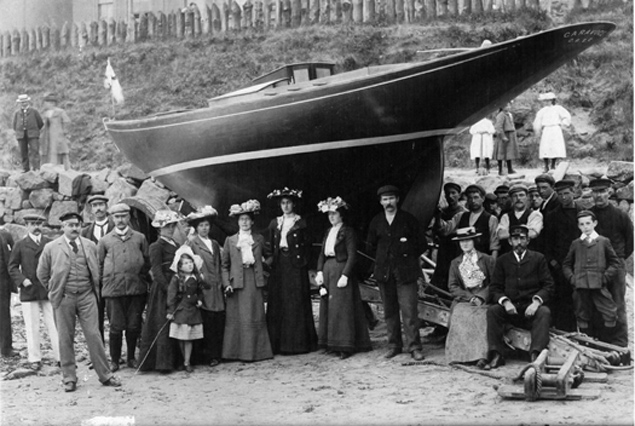 The Alfred Mylne-designed Dublin Bay 21 Garavogue, new-built and ready for launching by James Kelly of Portrush in 1903. Photo courtesy Robin Ruddock
The Alfred Mylne-designed Dublin Bay 21 Garavogue, new-built and ready for launching by James Kelly of Portrush in 1903. Photo courtesy Robin Ruddock
During that half century between 1895 and 1945 when many new local one design classes appeared, Ireland had a pioneering role, as the One Design concept had been first promoted by Thomas “Ben” Middleton’s Water Wags in Dublin Bay in 1887. Thus it was always an innovation which had special resonance in the Irish context, an ideal which it seemed only natural to follow.
Then too, the Royal Alfred YC of Dublin Bay had been promoting the virtues of amateur sailing since 1870 and earlier, so the level playing field provided by One-Designs was a natural follow-on for continuing such enthusiasm. But sustained and long-time support for a particular One-Design type – once it had proved itself satisfactory for the waters on which it sailed – also had much to do with the geography and social structure of Irish sailing.
Put simply, most sailors of the new and growing one design classes in Ireland lived in close proximity to where their boat were based and raced. In contrast elsewhere, thanks to the comprehensive 19th Century railway systems very effectively serving large conurbations such as London and Paris - and to a lesser extent Glasgow and New York - when the weekend was over, many owners and crews headed back to town, sometimes over quite long distances from their boat’s home port.
 Garavogue in the final stages of a race when the finishes were still within Dun Laoghaire Harbour. Her owner and crew would have lived within easy reach of the harbour, and the comfortable social bonds within the DB21 class contributed to its long life from 1902 to 1986.
Garavogue in the final stages of a race when the finishes were still within Dun Laoghaire Harbour. Her owner and crew would have lived within easy reach of the harbour, and the comfortable social bonds within the DB21 class contributed to its long life from 1902 to 1986.
But in Ireland, whether it was Cork, Dublin or Belfast, the boat was always nearby, you might meet your fellow sailors quite often during the working week, and evening racing was an important part of the programme. In the greater Dublin area in particular, the cohesive nature of society meant that once a class was popularly established, it thrived so much that some boats from the late 1890s and early 1900s are still in existence and actively racing today.
This means that when a boat-building school seeks a meaningful design which will give added depth to their activities, they know they only have to turn to the wide selection of historic Irish classes to find a boat of suitable size which will have an element of international recognition, it will give those building her an encouraging sense of connection to the past for instructors and trainees alike, and at a practical level, they know there’ll be a diligent class measurer to keep them on track as the job progresses.
A further alternative technical element is added when the no-longer-seaworthy old hull of a revered classic is acquired, and it is then patiently analysed in a process which is a mixture of dissection, re-build and re-creation. Either way, whether building from scratch, or re-creating through various levels of re-building, the learning process is given many useful extra facets.
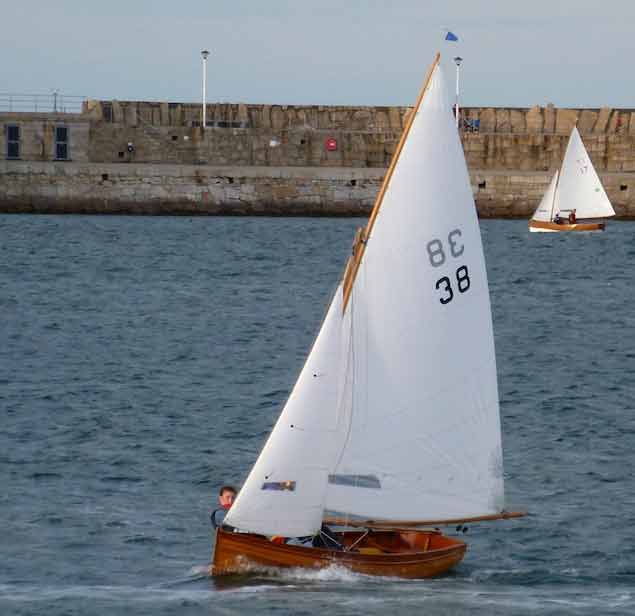 Water Wags in Dun Laoghaire Harbour. Founded as a class of 13-footers in 1887 and re-born in this larger 14ft 3in version by designer Maimie Doyle in 1900, they have become one of the most popular Irish classic designs for boat-building schools. Photo: W M Nixon
Water Wags in Dun Laoghaire Harbour. Founded as a class of 13-footers in 1887 and re-born in this larger 14ft 3in version by designer Maimie Doyle in 1900, they have become one of the most popular Irish classic designs for boat-building schools. Photo: W M Nixon
And as Irish sailors were not shy in asking designers of international repute to create their new One Designs for them, these re-build or new-build projects may have the added lustre of classic stardom with their undoubted historical significance. Thus in recent years while we may have had new boats being built to the old designs of Irish designers such as Maimie Doyle, Hebert Boyd, John B Kearney and O’Brien Kennedy, equally builders from abroad have been in touch with class associations and other sources in Ireland in order to re-create boats to the designs of William Fife and Alfred Mylne of Scotland, and Morgan Giles of England.
Thus at the moment we have Water Wags being built in Spain and America, Dublin Bay 24s are at various stages of being re-created in Spain, America and France, in France they have also built a Howth 17, another Water Wag and a Shannon One Design, it’s said there’s a Howth 17 being built in the boat-building training school attached to the US Naval Academy in Annapolis, and not surprisingly we hear of enquiries made of Irish class association from those havens of DIY boat-building enterprise, Australia and New Zealand.
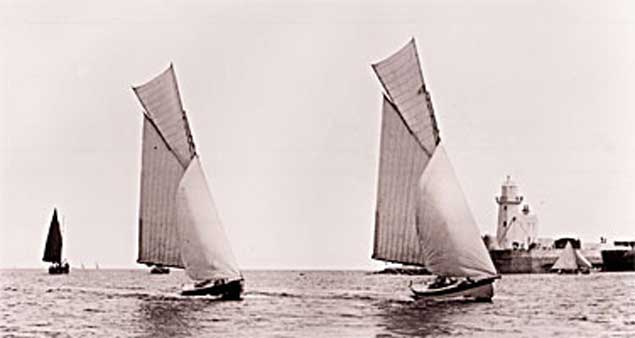 Two of the new Howth 17s in their first season in 1898, before sail numbers had been allocated.
Two of the new Howth 17s in their first season in 1898, before sail numbers had been allocated.
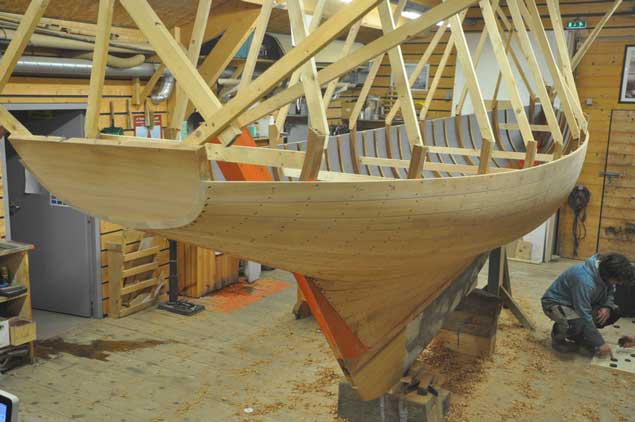 The Howth 17 Orla under construction at the Skol ar Mor boat-building school in France, May 2017
The Howth 17 Orla under construction at the Skol ar Mor boat-building school in France, May 2017
In fact, if we look at the range of living or still very well remembered classes in Ireland which have the potential to make designs available for such classics projects, the choice is remarkably comprehensive in size and type. They range through the 14ft IDRA 14s (O’Brien Kennedy, 1946), the 13ft and now 14ft 3ins Water Wags (R A MacAllister 1887 & Maimie Doyle 1900), the Castletownshend Ettes of the 1930s come in at 16ft, at 17ft you have both the Shannon One Designs (Morgan Giles 1922) and the Mermaids (John Kearney 1932), at 18ft we’re already into keelboats and the Belfast Lough Waverleys (John Wylie 1902), move up to 22ft and you have the Linton Hope-designed Fairy Class (1902) on both Belfast Lough and Lough Erne, and there were also the Fife-designed Belfast Lough Class IIIs of 1896, and then at 22ft 6ins there are the Howth 17s by Herbert Boyd (1898).
Up at 25ft there are the Glens (Alfred Mylne, 1945) in Dun Laoghaire Harbour and on Strangford Lough, and also on Strangford Lough at 28ft 6ins there are the Rivers (Alfred Mylne, 1920). Moving towards the 30-31ft mark, we have the Cork Harbour One Designs (William Fife 1896) and the Dublin Bay 21s (Alfred Mylne 1902), and finally above that, with all of them around the 37ft 6ins LOA size, are the Belfast Lough Class I (Fife 1897), the Dublin Bay 25s (Fife 1898) and the Dublin Bay 24s (Mylne, 1938).
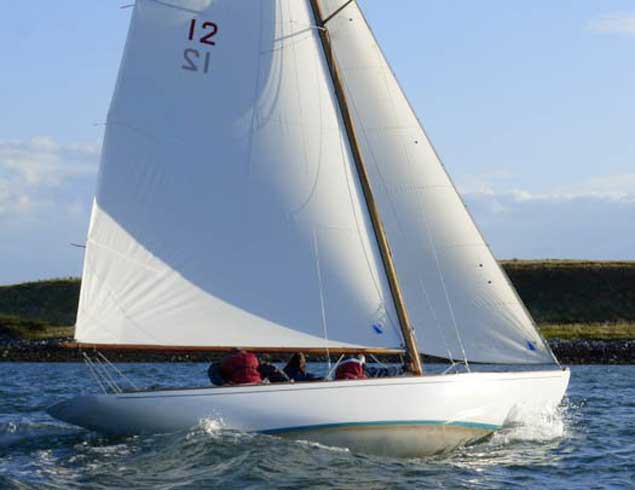 Strangford Lough River Class – designed by Alfred Mylne in 1920, they are believed to be the world’s first Bermudan-rigged One Design. Photo: W M Nixon
Strangford Lough River Class – designed by Alfred Mylne in 1920, they are believed to be the world’s first Bermudan-rigged One Design. Photo: W M Nixon
 The Dublin Bay 24 Periwinkle, an Alfred Mylne design of 1938, was restored in France
The Dublin Bay 24 Periwinkle, an Alfred Mylne design of 1938, was restored in France
The attraction of such a good selection is that anyone minded to re-create a classic with a distinguished design and sailing provenance can choose a boat of manageable size from the range available in Ireland. A genuine classic doesn’t have to be a biggie. Keeping it manageable – and in many cases keeping it comfortably trailerable – is the secret of a harmonious project, and the eclectic list of classic projects available for sourcing in Ireland not only offers boats of every size and type up to 40ft, but you can come to Ireland and absorb the atmosphere of the places where the idea of the boat was first conceived, and meet current enthusiasts for sailing the boat which gives a vibrant connection both to the present and the past.
Don’t assume, though, that though it may be happening abroad, there’s nothing going on in Ireland. On the contrary, the possibilities of the Irish classics have been exploited every which way. Serial classics enthusiast Hal Sisk of Dun Laoghaire has instigated so many projects that it’s difficult keeping track, but his CV includes the Peggy Bawn, new Water Wags built in classic style, glassfibre Colleens from an 1897 design, and currently the building of a Dublin Bay 21 from the original ballast keel upwards by Steve Morris of Kilrush, utilising multi-skin construction based on laminated frames.
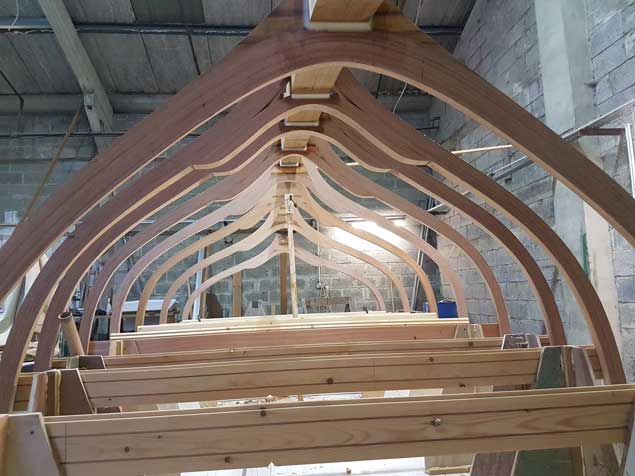 New life for the 1902-designed DB 21 Naneen in Steve Morris’s workshop in Kilrush. Photo: Steve Morris
New life for the 1902-designed DB 21 Naneen in Steve Morris’s workshop in Kilrush. Photo: Steve Morris
 The construction method may be new, but that’s undoubtedly the classic hull of a DB 21 emerging in Kilrush. Photo: Steve Morris
The construction method may be new, but that’s undoubtedly the classic hull of a DB 21 emerging in Kilrush. Photo: Steve Morris
As for Jimmy Furey on the Roscommon shores of Lough Ree, his examples of completely traditional classic style construction of Shannon One Designs and Water Wags – working most recently with Cathy MacAleavey – results in what can only be described as Chippendale work, while down in Ballydehob in West Cork there’s a whole nest of classic restorers, with Rui Ferreira setting quite a pace with new Ettes, a restored Kim Holman Stella, and a much-revived Howth 17.
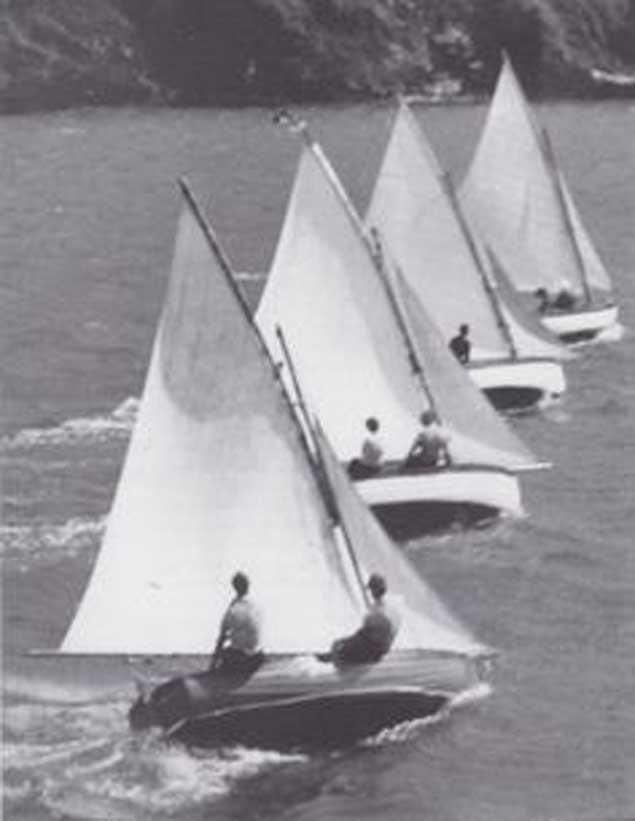 The Castlehaven Ette Class – Rui Ferreira has been building to this design
The Castlehaven Ette Class – Rui Ferreira has been building to this design
Over on the east coast, when times are hectic in classic boatbuilding, people have found that John Jones over in Anglesey does a very good line in stylish clinker construction, but the venerable Howth 17s – not all of which are operated on large budgets – are currently being kept going by Larry Archer of Malahide, who has a workshop up-country where three of these golden oldies are currently receiving the TLC.
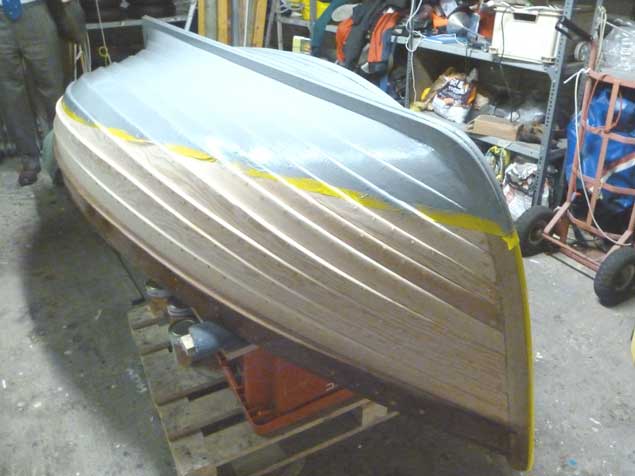 Asgard’s dinghy was re-created in classic style by Larry Archer. Photo: W M Nixon
Asgard’s dinghy was re-created in classic style by Larry Archer. Photo: W M Nixon
Larry is something of a renaissance man in the boat maintenance, repair and building arena, as he is right up to speed with everything to do with glassfibre, yet when Pat Murphy and his group got together to re-create Asgard’s dinghy, it was Larry Archer who delivered the goods, beautifully built in classic clinker style.
As to his present work with the Howth 17s, that is part of a broader project being driven by Ian Malcolm and fellow Seventeen sailors, who may be looking at a class of 23 boats in the foreseeable future. Apart from the new boat built last year in France and the boat reputedly under construction in Annapolis, in a secret workshop on the Hill of Howth, yet another new Howth 17 is quietly under construction to a very high standard.
Such things take time, as the group in Clontarf Y & BC demonstrated when they set out to build a classic timber IDRA 14 for the class’s 70th Anniversary in 2016. They allowed themselves plenty of time, but it was tight enough in the end, yet by the successful conclusion a special bond had been formed among the build team in their Men’s Shed enterprise. It said everything about the deeper benefits of getting involved in a manageable project using time-honoured methods and traditional materials to create something of lasting beauty, value and utility.
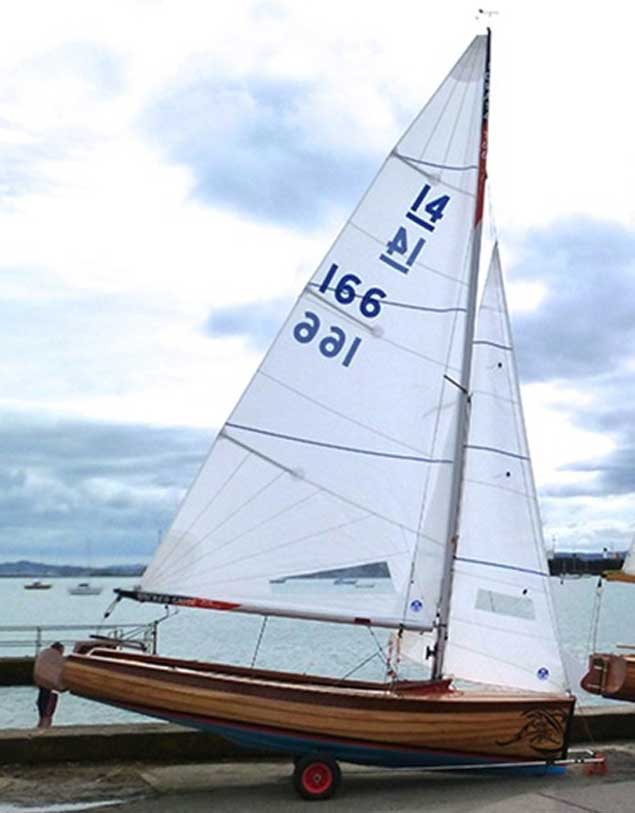 The new IDRA 14 ready for launching at the class’s 70th Anniversary Regatta at Clontarf. Photo: W M Nixon
The new IDRA 14 ready for launching at the class’s 70th Anniversary Regatta at Clontarf. Photo: W M Nixon
When a yacht is one hundred years old, it might be normal to celebrate the event, perhaps by breaking open a bottle of champagne with a few close friends, or having a small celebratory article printed in ‘Afloat.ie’, or even head off on a remarkable cruise, to celebrate such a long survival.
However, the Shannon one-design class, designed by Francis Charles Morgan-Giles (1883-1964) built their preview boat in 1921 (which no longer survives), and trials were offered to sailors on the Shannon River, in order to promote the idea of a one-design for the Shannon. Everybody who sailed the new boat were impressed, and during the winter and spring of 1922, nine boats were built to the new design, seven of which were built by Walter Levinge of Creaghduff, Athlone, Co. Westmeath. Numbering started at No. 32, so these new boats were Nos. 33, 34, 35, 36, 37, 38 and 40.
In 2017, the surviving boats, Nos. 32, 33, 37 and 40, celebrated their 95th birthday, so, it was decided to have a pre-regatta, in preparation for a bumper centenary regatta in 2022. It was the owners of No. 37, ‘Kiwi’, Peter and Owen Delany and their siblings, who put together the idea of the pre-centenary regatta to be held at Lough Ree Yacht Club (Est. 1770) over the weekend of 29-30 July. A notice was circulated to the owners of the other 95 year olds, and to all the newer Shannon one-design owners (most recent boat in No. 179), and 15 boats turned up to race and to party.
On Saturday, the wind was 12-25 knots which resulted in one compulsory reef. Race one went to the opportunistic Alan and DJ Algeo in No. 138. Then, after lunch, race two was won by Andrew Mannion in No. 97, who also managed to win race three. This was followed by a Pimms party, and dinner for eighty celebrants in the Lough Ree clubhouse.
On Sunday, the rain belted down, but the wind was lighter, so the reef was no longer mandatory. Racing north of the Yellow Islands, saw Miss Georgina Corbett in No. 108 win race four, and race five was won by veteran sailor Frank Browne in No. 86. The final race after lunch was held in the flukey waters close to the clubhouse, and was won by Harmon Murtagh Snr and Jnr. as popular winners.
However, there were no discards in the six race series, which resulted in Miss. Corbett being declared the overall winner by one point from Dr. Mark McCormack on No. 50 which was built in 1925. For full results see below, and all SOD sailors are welcome back in 2022.
The annual Long Distance Race for Shannon One Designs (SOD’s) took place last weekend (24th & 25th July) under the Burgee of Lough Ree Yacht Club.
As Afloat.ie reported earlier, this year was more special than usual as it was Edwin Hunter’s (Race Officer), 50th Anniversary running the racing. The race is reputed to be the longest inland dinghy sailing race in the world and originated from the need of Sailors to transport their boats from Lough Ree Yacht Club to their sister Club, Lough Derg YC, so boats could compete in both annual regattas. Even with the advent of road transport, the race sustained and has grown from strength to strength.
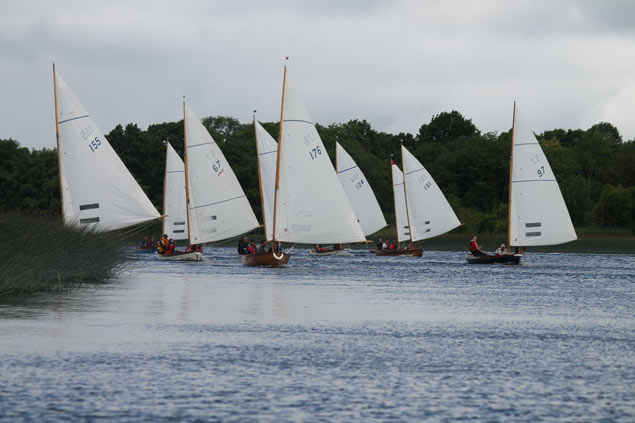 (Above and below ) A record fleet of Shannon One Designs turned out Photo: Garrett Leech
(Above and below ) A record fleet of Shannon One Designs turned out Photo: Garrett Leech
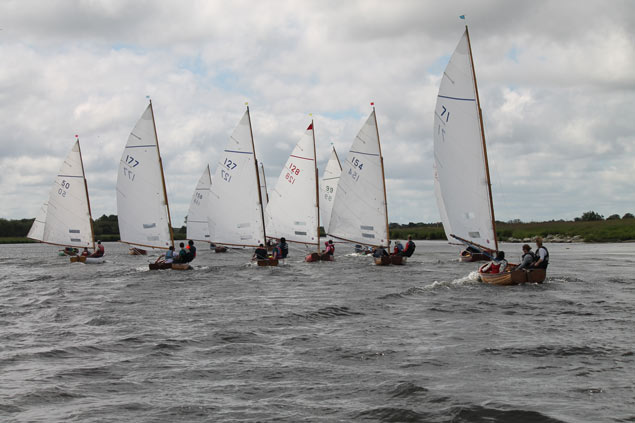
A record fleet turned out for the occasion which started from Lough Ree YC. 36 SOD’s departed the Club and while initially racing north up Lough Ree, they then descended south to the town of Athlone where the race finished its first leg just above the Town bridges. This was aided by a fresh north westerly breeze. The SOD’s & their extensive entourage locked through at Athlone and started their 2nd harrowing leg to Clonmacnoise, some of which had the wind on their nose, making for interesting navigation for all boat users as they weaved their way back and forth the river!
After the sailors had their traditional restorative in Kileen’s pub in Shannon Bridge, the fleet took off once more for their final destination of the day, Banagher. Here the party really started, with nearly 150 people sitting down on the quay wall for a BBQ. A Presentation was made to Ed in recognition of his 5 decades of hard work!
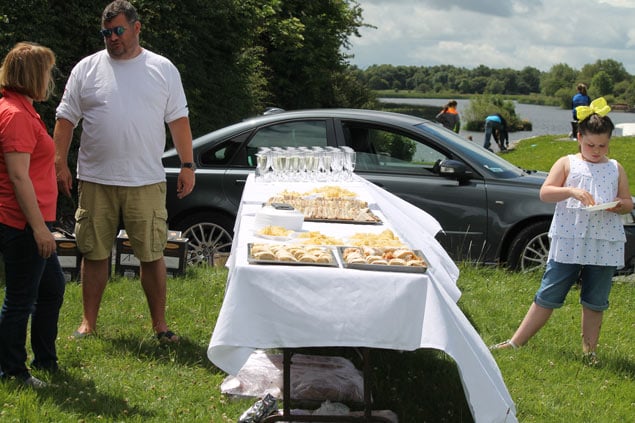 During the course of the race fine refreshments were provided for the tired sailors. Photo: Garrett Leech
During the course of the race fine refreshments were provided for the tired sailors. Photo: Garrett Leech
With no mercy or consideration for the revelry of the previous evening, racing again commenced at 10:30 and the fleet continued weaving their way downstream to Victoria Lock, Meelick and through the many other craft using the waterway. Here, fine refreshments were provided for the tired sailors, before they headed on their merry and final leg of the race, to Portumna.
Overall first place went to David Dickson (SOD 73), Second Andrew Mannion (SOD 97) & Third, Frank Browne (SOD 86).

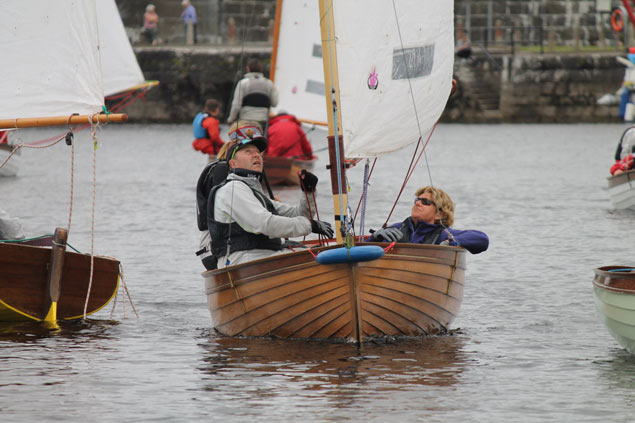
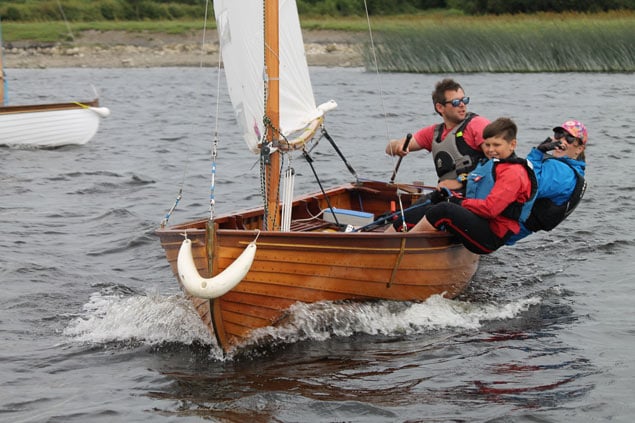

Entries Still Open For Shannon One Design Long Distance Race
#SOD - The Shannon One Design Association (SODA) has announced its latest Long Distance Race for the weekend of Saturday 24 and Sunday 25 June.
First raced in 1953, the Shannon One Design (SOD) competition is the longest inland dinghy sailing race in these islands.
And it’s a challenging one at that, with crews counting tacks often into the thousands while jockeying for position down a narrow river given to serious south-westerlies, though a northerly breeze can make for enjoyable downwind racing.
Either way, the race remains physically and mentally demanding over the two days, says SODA chairman John Leech, whose own mother crewed the race’s winning SOD in its inaugural outing, topping it with a win in her own right in the race's second year.
Race officer Edwin Hunter, who celebrates his 50th year in charge of proceedings, is also making it a family affair as his son and assistant David will take over his duties from 2018 onwards.
The race starts in Lough Ree Yacht Club on the Saturday, with the first leg taking the fleet to Athlone Lock.
From there the race continues to Clonmacnoise (leg 2) for lunch, Shannon Bridge (leg 3) and Banagher (leg 4), then resumes Sunday to Meelick Lock (leg 5) before finishing in Portumna (leg 6).
Leech expects a sizeable fleet of up to 50 boats this year and late entries are still welcome — anyone interested in taking part should contact the SODA Honorary Secretary at [email protected] for details.
#shannononedesign – Lough Ree Yacht Club, the recent hosts of the Round Ireland on the inside race and more recent Laser Connaughts, held a special regatta at the weekend (27th-28th July) to celebrate the 50th Anniversary of a remarkable river boat the 'M.V. Harklow' which was designed and built by the renowned Arklow boatbuilder Jack Tyrell for the international yachtsman Douglas Heard, the first President of the Irish Dinghy Racing Association and Commodore of the Royal St. George Yacht Club. The regatta was ably organised by her present owner Dan O'Connor.
A fleet of 18 Shannon-One-Designs competed in the warm summer conditions. In race one, the force 2 wind was from the south east, but quickly backed to the north east causing difficulty to the OOD who had laid the course close too close to the Yellow Islands. There were no opportunities for overtaking. The winner was Frank Browne/Julie Delany/crew in No. 86 followed by Owen/Mags/ Margaret Delany in No. 37 and. Mark McCormick/ crew in No. 50. It was already looking like a regatta in which the older boats might dominate.
The second race, held after lunch, in the open lake with the windward mark close to Little Yellow Island in slightly steadier conditions, was won by Rory Walsh/crew in the beautifully prepared No. 170 from 50 and 86 third.
The third race with a handicap start was started off the yacht Club pontoons was won convincingly by Cathy MacAleavey/Philip Dilworth/crew in the newest boat competing, No.178, but this race was subsequently declared null and void by the protest committee under the careful eye of David Beatty, after one crew protested the entire fleet for sailing the wrong course.
This was followed by a dinner for the competitors and their friends when the Harklow cake was formally cut by Ruth Heard and her daughter Professor Hilary Biehler Delany, followed by Dr. Harmon Murtagh who gave an informative talk on the significance of the M.V. Harklow and her owners. 'The Nuts' a musical group managed by the regatta organiser bashed out 1960's music for the rest of the night to the delight of those who wanted to dance.
On Sunday, after the protest was heard, the first race was held close to Beam Island in a light shifty wind and thundery conditions. Initially Commodore Alan Algeo/DJ/Crew lead the first lap of the race, but on the second beat the shifty wind foiled them, and allowed No. 176 sailed by Harmon Murtagh/Harmon Jnr/crew to win, from Eoin Carrol/ crew in No. 60 and Graham McMullin and family in No. 151.
The second race was held back to back in a wind which was shifting back and forth by up to 80degrees. Thunder and lightning was showing its anger on all sides of the course. It was won by Ian Croxon / crew in No. 56 from No.60 and No. 170. These boats were fortunate to finish before the stair-rods arrived. And about 25mm of rain fell in half an hour. Due to the warm conditions many of the crews were not wearing heavy rain gear and were soaked.
For full race results download the attached xcel file below.































